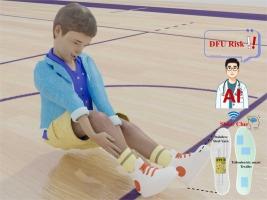Highly Reliable Shear Sensitive Triboelectric Smart Textile for Intelligent Gait Analysis Toward Early Detection and Offloading Rehabilitation of Diabetic Foot Ulcers
IF 17.1
1区 材料科学
Q1 CHEMISTRY, PHYSICAL
引用次数: 0
Abstract
Diabetic foot ulcers (DFUs) are a severe complication of diabetes that leads to substantial morbidity and mortality. Quantifying compressive and shear stresses during the gait process provides an effective approach for assessing the early risk of DFUs and enabling timely intervention. However, current gait analysis devices suffer from a critical lack of shear stress detection capability, as well as limitations related to comfort, privacy concerns, and long-term stability. This paper proposes a shear stress sensitive triboelectric smart textile sensing system for intelligent gait analysis. The system comprises a smart insole featuring a triboelectric smart textile array in high-stress foot regions, a flexible printed circuit board (FPCB) for signal transmission, and a self-attention based multi-modal recognition software. An interlocked hill structure, inspired by mammalian skin, is integrated into the triboelectric smart textile. This structure helps focus and amplify localized stress, enabling rapid acquisition of external stimulus information with high sensitivity (0.062 V/kPa for shear stress, 0.05 V/kPa for compressive stress), fast response (less than 20 ms), stable (enduring 40000 cycles), and accurate sensing of a wide stress range (0-200 kPa). The compressive and shear stress cues obtained from the triboelectric smart textile are feature-extracted and model-fitted by a meticulously designed multi-label sequence data recognition neural network model based on self-attention mechanisms. Inter-module communication among multiple prediction heads enables deep gait-related insights, enhancing the models generalization, computational efficiency, and interpretability. The system supports patient identity recognition, early detection and offloading rehabilitation of DFUs, offering a low-cost, energy-efficient, and universally applicable solution for next-generation smart healthcare systems.

用于糖尿病足溃疡早期检测和卸载康复的智能步态分析的高可靠剪切敏感摩擦电智能纺织品
糖尿病足溃疡(DFUs)是糖尿病的严重并发症,可导致大量发病率和死亡率。量化步态过程中的压缩和剪切应力为评估DFUs的早期风险和及时干预提供了有效的方法。然而,目前的步态分析设备严重缺乏剪切应力检测能力,以及与舒适性、隐私问题和长期稳定性相关的限制。提出了一种用于智能步态分析的剪切应力敏感摩擦电智能纺织品传感系统。该系统包括一个智能鞋垫,在高应力脚区域具有摩擦电智能纺织品阵列,用于信号传输的柔性印刷电路板(FPCB),以及基于自注意的多模态识别软件。受哺乳动物皮肤的启发,一个互锁的山丘结构被集成到摩擦电智能纺织品中。这种结构有助于聚焦和放大局部应力,能够快速获取高灵敏度的外部刺激信息(剪切应力为0.062 V/kPa,压应力为0.05 V/kPa),快速响应(小于20 ms),稳定(持续40,000次循环),并能准确感知宽应力范围(0-200 kPa)。通过精心设计的基于自注意机制的多标签序列数据识别神经网络模型,对摩擦电智能纺织品的压剪应力信号进行特征提取和模型拟合。多个预测头之间的模块间通信使深入的步态相关的见解,提高模型的泛化,计算效率和可解释性。该系统支持患者身份识别、dfu的早期检测和卸载康复,为下一代智能医疗系统提供低成本、节能和普遍适用的解决方案。
本文章由计算机程序翻译,如有差异,请以英文原文为准。
求助全文
约1分钟内获得全文
求助全文
来源期刊

Nano Energy
CHEMISTRY, PHYSICAL-NANOSCIENCE & NANOTECHNOLOGY
CiteScore
30.30
自引率
7.40%
发文量
1207
审稿时长
23 days
期刊介绍:
Nano Energy is a multidisciplinary, rapid-publication forum of original peer-reviewed contributions on the science and engineering of nanomaterials and nanodevices used in all forms of energy harvesting, conversion, storage, utilization and policy. Through its mixture of articles, reviews, communications, research news, and information on key developments, Nano Energy provides a comprehensive coverage of this exciting and dynamic field which joins nanoscience and nanotechnology with energy science. The journal is relevant to all those who are interested in nanomaterials solutions to the energy problem.
Nano Energy publishes original experimental and theoretical research on all aspects of energy-related research which utilizes nanomaterials and nanotechnology. Manuscripts of four types are considered: review articles which inform readers of the latest research and advances in energy science; rapid communications which feature exciting research breakthroughs in the field; full-length articles which report comprehensive research developments; and news and opinions which comment on topical issues or express views on the developments in related fields.
 求助内容:
求助内容: 应助结果提醒方式:
应助结果提醒方式:


